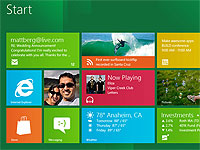With Windows 8, Microsoft is looking to make the operating system and the software that runs on it more efficient. This is important for this version of Windows because there will be a variant, called Windows on ARM (ARM), that runs on tablet-friendly ARM processors.
In an MSDN blog post, Steven Sinofsky, president of Windows and Windows Live, explains the new philosophy behind running apps on Windows 8:
For Windows 8, we started off with a rule that would apply to the large majority of Metro style apps: if an app is not on screen, and the screen is not on, it should not impact your battery life. …When an app is not in the foreground, we wanted to ensure that it would either suspend completely, or use limited resources based on a set of common background capabilities (like copying files), which the app can access.
Sounds similar to how smartphone and tablet apps work, by and large. What’s interesting is that Microsoft wants this “foreground-based approach” to extend to all software going forward.
Of course, as we keep saying, desktop applications that you currently have will work exactly like they do on Windows 7 today (and were even improved in many dimensions). But over time, we’re equipping Windows to get more done and use less power, with new applications that help you get that work done—from entertainment to professional tools and everything in between. The resources available to compute, the resources required, and the types of computation done are changing, and Windows 8 is providing new facilities to tap into this opportunity.
Windows 8 also “suspends” apps when you switch out of them (Alt-Tab out and the like), which means that Windows scheduler removes them from the processing queue, so to speak. This allows CPUs to enter low-power states more often.
But what about apps that require background processing? Don’t worry, the Windows team has got that covered too with a set of background multitasking APIs that handle stuff like background music, receiving VoIP calls and device syncing.
Be sure to read up on the rest of what’s new in Windows 8 power management here.


Leave a Reply